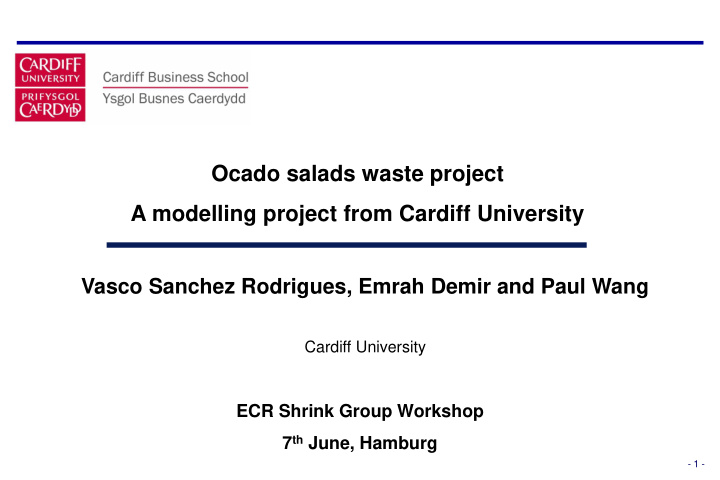



Ocado salads waste project A modelling project from Cardiff University Vasco Sanchez Rodrigues, Emrah Demir and Paul Wang Cardiff University ECR Shrink Group Workshop 7 th June, Hamburg - 1 -
Structure of the presentation ❑ Background, key facts and potential solutions ❑ Project scope and aims ❑ Initial visual model ❑ Project stages ❑ Further research post-project completion - 2 -
Key facts on food waste ❑ Globally, the total amount of food waste is approximately 1.3 billion tons (The Telegraph, Jan 2018) - approximately 28 percent of the world’s agricultural land area. ❑ Food losses/waste: £493Bn (developed countries) & £225 Bn (developing countries). ❑ 8.4m people struggle to afford a meal, according to the UN's FAO – while the wasted food is approximately £13 Billion worth of edible food each year. ❑ Most of the food waste (61%) is avoidable and could have been eaten if it had been managed - 3 - better.
Some recent UK news on salad waste - 4 -
Risks for retailers and potential solutions IDG advice on food waste reduction Potential risks Make food waste reduction a priority. Budget conscious consumers could steer away from purchase, Measure waste in detail and track the cause of each incident back to its source. for example if a product is not available in small packaging sizes. Engage with trading partners and share Repeat purchasing is less likely, relevant information. Often the root cause especially if competitors or of waste are decisions made elsewhere in the chain. substitutable products provide a lower waste solution. For ambient products, introduce a zero Reputation can be harmed if a tolerance policy for waste, whether it be particular product or company is for damage, date expiries or obsolete lines. associated with waste. Government intervention becomes Take offsetting actions to reduce the net more likely waste of retail supply chain (Institute of Grocery Distribution, 2013) - 5 -
Project partners - 6 -
Project Scope ❑ This is a pilot project, the start of a journey, not the journey itself. ❑ Salad product families have been selected due to perishability, seasonality and waste levels. ❑ The project is focusing on designing a methodology to measure salad waste generated from farm to customer’s bin. ❑ The product facilities included in the data collection are any raw salad products, including mixed salads and any raw vegetables used by customers to prepare salads at home. This excludes sauces, meat, cheese and any other non-salad products. ❑ The project team plans to collect food waste input data from a sample of Ocado suppliers, charities, food banks and customers, as well as from the two main Ocado CFCs. - 7 -
Project Aim and Objectives This project aims to estimate the total wasted materials generated from the Ocado salads supply chain and the impacts of those wasted materials on CO2 emissions and blue water footprint. The objectives of this project are as follows: ❑ Identify the main causes of salad waste along Ocado salad supply chain. ❑ Measure the total wasted amount of salad at every stage of Ocado salads supply chain. ❑ Develop specific KPIs to measure direct (total food and packing waste) and indirect impacts of salads waste (loss sales, cost, CO 2e emissions and blue water print). ❑ Undertake sensitivity analysis to establish how waste can be reduced across the Ocado supply chain. - 8 -
Initial Visual Model - Typical Ocado Salads Supply Chain Supplier Total cost Blue water CO 2 e Food waste Packer Ocado local Ocado CFC Ocado customer Charity Research method: 1) Input data from Ocado 2) Supplier/customer survey 3) Simulation 4) Multi-variable optimisation - 9 -
Mental Map of the Research Problem Harvest Customer Order lead-time, quality eating habits ATP target Supplier Supplier Ocado order Ocado Customer production stock quantity stock order quantity Crop Salad Transportation, waste waste Delivery Blue $$$ CO2e water - 10 -
Project Stages and Expected Outputs Stage Description Outputs Stage 1 Model scope and data screening Data collection scope (March 2018) Process map Initial model Stage 2 Data collection requirements informed to Agreed data sample (April 2018) Ocado Stage 3 Data collection process Initial model (May – July 2018) Roll-out of customers and supplier Initial food waste measurement questionnaires tool Generation of internal Ocado dataset with the inbound and outbound waste related data Survey of a sample of food charities Stage 4 Model refinement Refined model (August – Sept 2018) Refined food waste measurement tool Stage 5 Dissemination Project report (October 2018) Case study brief - 11 -
Further research post-project completion ❑ Replicate/apply the methodology to other food product categories. ❑ Develop a multi-variable optimisation model - trade-offs, major food waste sources and factors, and test potential solution. ❑ Undertake applied research on circular economy innovations adopted in industry to reduce net food waste. ❑ Undertake an in-depth study on consumer food waste to design and test marketing experiments that can be used to reduce food waste. - 12 -
Any ideas of further research ❑ In the inbound supply chain, which are the key priority areas (e.g. forecasting, inventory control, inventory accuracy and/or supplier order policy)? ➢ Do you recommend us to focus on any of these areas? ❑ What about the outbound supply chain? Pricing & promotion / forecasting & inventory optimisation? ➢ Is it worth for us to undertake research on the dynamic trade-offs between price discounts, forecasting errors, stock quantities and food waste? ❑ What about research on circular economy? ➢ Which areas of circular economy should we focus on? ❑ Any other ideas on further research? - 13 -
Thank you for your attention - 14 -
Recommend
More recommend